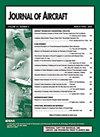Aeroelastic Analysis of Highly Flexible Wings with Linearized Frequency-Domain Aerodynamics
IF 2.1
3区 工程技术
Q2 ENGINEERING, AEROSPACE
引用次数: 0
Abstract
Aeroelastic flutter analysis of configurations with geometric structural nonlinearities typically is done with time-domain analysis. The results from this process are computationally expensive and can yield cumbersome results that may be difficult to manage and interpret. Compared to time-domain methods, frequency-domain flutter analysis can provide additional insight into the characteristics of a flutter instability. By linearizing the aeroelastic problem about the nonlinear equilibrium state, this work applies frequency-domain aeroelastic analysis to the Pazy wing, the subject of the Large Deformation Working Group in the Aeroelastic Prediction Workshop. Generalized aerodynamic forces (GAFs) are computed with both a doublet-lattice method and a computational fluid dynamics solver at a range of reduced frequencies as well as a range of dynamic pressures to account for the dependence of the mode shapes on the nonlinear equilibrium state. These GAFs are used in a [Formula: see text] flutter solver, which is modified to handle the nonlinear dependence of the stiffness matrix and GAFs on the dynamic pressure. The hump mode flutter mechanism predicted by the linear doublet-lattice method is found to underpredict the severity of the instability, relative to the computational fluid dynamics-based tool, though the overall static and dynamic aeroelastic mechanisms predicted by the two fidelities are similar.基于线性化频域空气动力学的高柔性机翼气动弹性分析
具有几何非线性结构的气动弹性颤振分析通常采用时域分析方法。此过程的结果在计算上是昂贵的,并且可能产生难以管理和解释的繁琐结果。与时域方法相比,频域颤振分析可以提供对颤振不稳定性特征的额外见解。通过线性化关于非线性平衡状态的气动弹性问题,本工作将频域气动弹性分析应用于气动弹性预测车间大变形工作组的课题——Pazy翼。采用双点阵法和计算流体动力学解算器在一定频率范围和动压力范围下计算广义气动力(gaf),以考虑模态振型对非线性平衡状态的依赖性。这些gaf用于[公式:见文本]颤振求解器,该求解器经过修改以处理刚度矩阵和gaf对动压力的非线性依赖关系。与基于计算流体动力学的工具相比,线性双点阵法预测的驼峰模态颤振机制低估了不稳定性的严重程度,尽管两种保真度预测的整体静、动气动弹性机制相似。
本文章由计算机程序翻译,如有差异,请以英文原文为准。
求助全文
约1分钟内获得全文
求助全文
来源期刊

Journal of Aircraft
工程技术-工程:宇航
CiteScore
4.50
自引率
31.80%
发文量
141
审稿时长
6 months
期刊介绍:
This Journal is devoted to the advancement of the applied science and technology of airborne flight through the dissemination of original archival papers describing significant advances in aircraft, the operation of aircraft, and applications of aircraft technology to other fields. The Journal publishes qualified papers on aircraft systems, air transportation, air traffic management, and multidisciplinary design optimization of aircraft, flight mechanics, flight and ground testing, applied computational fluid dynamics, flight safety, weather and noise hazards, human factors, airport design, airline operations, application of computers to aircraft including artificial intelligence/expert systems, production methods, engineering economic analyses, affordability, reliability, maintainability, and logistics support, integration of propulsion and control systems into aircraft design and operations, aircraft aerodynamics (including unsteady aerodynamics), structural design/dynamics , aeroelasticity, and aeroacoustics. It publishes papers on general aviation, military and civilian aircraft, UAV, STOL and V/STOL, subsonic, supersonic, transonic, and hypersonic aircraft. Papers are sought which comprehensively survey results of recent technical work with emphasis on aircraft technology application.
 求助内容:
求助内容: 应助结果提醒方式:
应助结果提醒方式:


